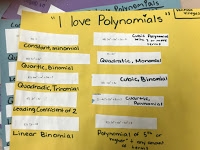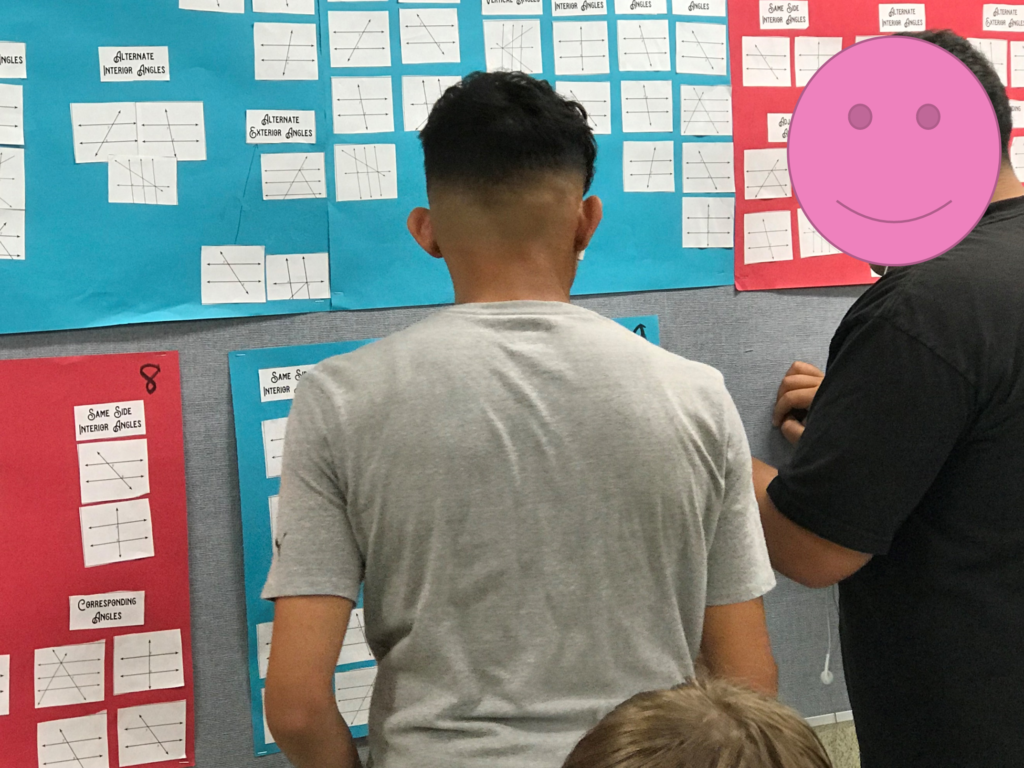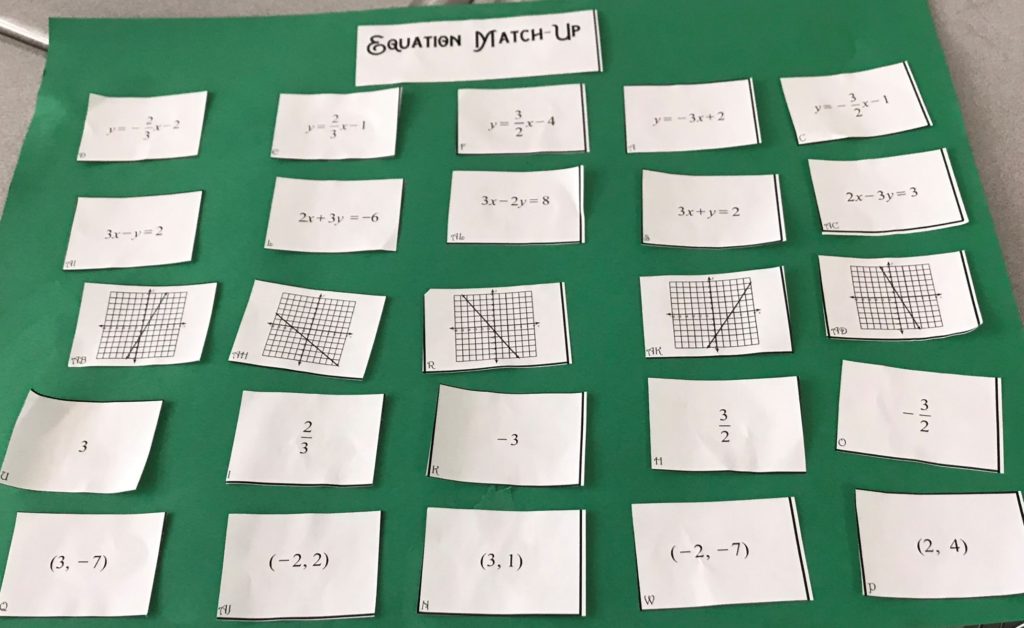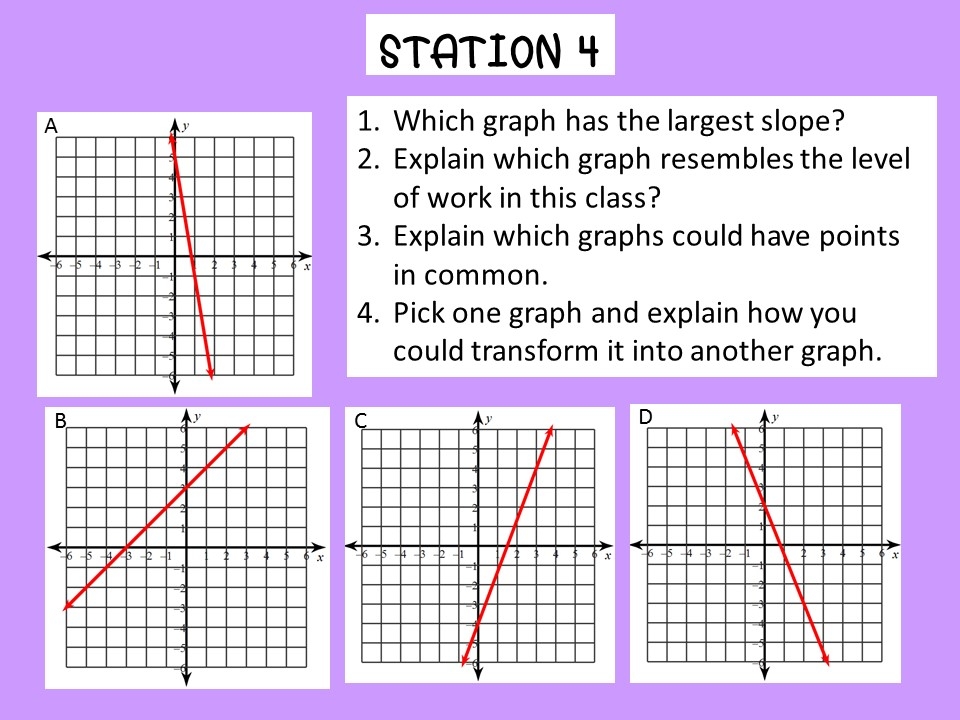If you are looking to increase student discussion as well as movement in the classroom, try a gallery walk. A gallery walk is simply a active teaching strategy where students move around the room viewing, discussing and commenting on something.

That something could be text, images or in many cases a poster of work. It is very similar to a station activity, but instead of stopping at a station and creating/completing something, they are discussing and commenting. While you can use anything in a gallery walk, some items work better for the math class.
Gallery Walks with Posters
When students have created posters, I place them on the wall and have other students view and remark on them. One of the activities I used was the I Love Polynomials activity discussed in a previous blog post. https://bluemountainmath.com/i-love-polynomials
In that activity, I called out vocabulary words/phrases about polynomials and students raced to find an example of that vocabulary in a bin. The posters were completed that day, and the next day they were displayed on the wall. Students then viewed the posters in groups of 3, used sticky notes to add a positive remark, a question and an area of improvement for each poster.

I also used this after a lesson taught on parallel lines cut by a transversal. Students need the vocabulary to be successful so they received the titles, and examples of each (with a few non examples) and were asked to assemble a poster.

Names were placed on the back of posters and were numbered. Students were asked to provide feedback on a form for each of the numbered posters.
Why Use This Strategy
This provided opportunities for students to:
1. See other work and compare to their own–It is a low stress way to view examples of work and see how their own work measures to the class.
2. Review the words again–Students need to see the same material in different ways several times before it moves to long term memory.
3. Error analysis–Other students can catch errors, sometimes students catch their own errors.
4, Moving around the class stimulates learning, is relaxing and increases discussion.
5. It is a way to review before assessments to increase success.
6. Short on wall space? You can use in stations. Have the material on desks around the room and have students rotation. Or have a Chrome book at each station with a different digital video, image or recording that students view, discuss and record.
Gallery Walks with Equation Sorting
In another activity, used to review before a test, students were given graphs and equations written in both standard and slope intercept form. Students took the parts, matched them up (except for the distractors) and created posters for a gallery walk the next day.

The posters then became anchor charts in the classroom that students could view as reminders.
Gallery Walks with Graphs
Content does not always have to be posters. You can post different graphs and ask students to write equations. Or have students view a page of several graphs and ask students which graphs have points in common.

When to Use a Gallery Walk
A gallery walk does not have to be used as a culminating activity, but can be used anytime to engage students.
–Try beginning a unit with a gallery walk of foundational skills that will be needed and ask students to respond.
–Or use in the middle to see how students are progressing and discover misconceptions.
–Use instead of a typical assessment and ask students to finish the steps.
–After a break, vacation, weekend to review prior lessons.
Steps for Success
If you have not used a gallery walk, here are some steps to get you started.
Step 1: Create/Curate topics/images about the current unit of study and make posters for each of the “portraits” in the gallery.
Step 2: Create questions or ideas that you want your students to answer or reflect on.
Step 3: Form student groups of 2-3. There should be one portrait or station for each group. Provide recording sheets for students to write on, or sticky notes to write on and add to that recording sheet.
Step 4: After 3 or 4 minutes, have the students rotate to the next place. Monitor the students as they work to clarify any questions about procedures .
Step 5: Continue rotating to each place until all students have visited each portrait.
Step 6. Discuss and Reflect: At this point, have students play a few rounds of move and repair. Students can compare their notes about each station with a new partner or small group.
Digital Versions of Gallery Walks
This is a strategy that can also be used digitally. I suggest using it in breakout rooms in groups so students are still working collaboratively.
Google Slides: Students can create something and post a link to a shared google slide presentation. When all the links have been posted (teachers need to verify links before sharing with class) the presentation is reviewed by all students.
Jamboard: Post the material on Jamboards. Have students view each of the Jamboards and leave a sticky notes with their questions and comments. Make sure students put their name on the sticky notes.
Padlet: Post the material on Padlet and students can add a comment. You can post images, links to other sites, videos and audio. Teachers with a free account can have 3 different Padlet boards. Once my class has finished the board, I close it and open another.
I always love using gallery walks in my class because students seem so engaged, conversations are lively and it makes a great review before an assessment. I even had a student tell me he “loves this activity because I can see what I did wrong and ways to improve”. If you have used gallery walks in your class, I would love to hear how you implemented them. Comment or drop me an email at bluemountainmath@gmail.com.










Leave a Reply